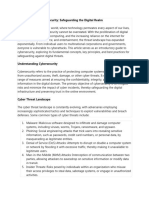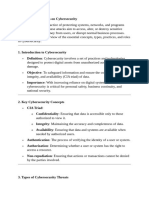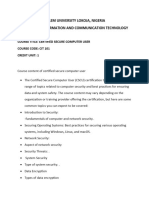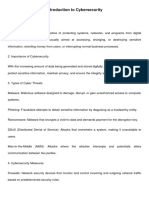0 ratings0% found this document useful (0 votes)
2 viewsSecuring Information Systems
Systems and information security encompasses practices and technologies aimed at protecting digital assets and ensuring the confidentiality, integrity, and availability of information. Common threats include malware, phishing, and denial of service attacks, with solutions such as firewalls, encryption, and security awareness training. Organizations must prioritize security to combat cyber threats, comply with regulations, and maintain business continuity.
Uploaded by
haze3018Copyright
© © All Rights Reserved
Available Formats
Download as DOCX, PDF, TXT or read online on Scribd
0 ratings0% found this document useful (0 votes)
2 viewsSecuring Information Systems
Systems and information security encompasses practices and technologies aimed at protecting digital assets and ensuring the confidentiality, integrity, and availability of information. Common threats include malware, phishing, and denial of service attacks, with solutions such as firewalls, encryption, and security awareness training. Organizations must prioritize security to combat cyber threats, comply with regulations, and maintain business continuity.
Uploaded by
haze3018Copyright
© © All Rights Reserved
Available Formats
Download as DOCX, PDF, TXT or read online on Scribd
You are on page 1/ 3
Securing Information Systems
Definition of Systems and Information Security
Systems and information security refers to the practices, policies, and
technologies employed to safeguard digital assets, networks, and data from
unauthorized access, breaches, or damage. The goal is to ensure confidentiality,
integrity, and availability (CIA) of information. Confidentiality ensures that
sensitive data is accessed only by authorized individuals. Integrity ensures the
accuracy and reliability of data. Availability guarantees that information is
accessible when needed.
Threats, Attacks, and Their Possible Solutions
Common Security Threats and Attacks
1. Malware – Includes viruses, worms, ransomware, and spyware that
damage or disrupt systems.
2. Phishing – Fraudulent attempts to obtain sensitive information through
deceptive emails or messages.
3. Denial of Service (DoS) and Distributed Denial of Service (DDoS)
Attacks – Overwhelm a system with excessive requests to disrupt
operations.
4. Man-in-the-Middle (MitM) Attacks – Interception of communications
between two parties to steal or alter data.
5. SQL Injection – Exploits vulnerabilities in databases to manipulate or
access unauthorized information.
6. Zero-Day Exploits – Attacks targeting undisclosed or unpatched security
vulnerabilities.
Possible Solutions
Use of Firewalls – Prevent unauthorized access to networks.
Encryption – Protect data integrity and confidentiality.
Antivirus and Anti-malware Solutions – Detect and eliminate
malicious software.
Multi-Factor Authentication (MFA) – Strengthen user authentication
mechanisms.
Security Awareness Training – Educate users on recognizing and
mitigating threats.
Regular Software Updates and Patching – Fix security vulnerabilities
promptly.
Need for Information and Information System Security and Control
Protection Against Cyber Threats – Organizations must defend against
increasing cyberattacks.
Compliance with Regulations – Legal frameworks like GDPR, HIPAA, and
ISO 27001 mandate strong security measures.
Preserving Business Continuity – Preventing security breaches ensures
uninterrupted business operations.
Safeguarding Sensitive Data – Protecting personal, financial, and
proprietary information.
Building Trust and Reputation – Consumers and stakeholders trust
businesses that prioritize security.
Network Security
Network security focuses on protecting data integrity, confidentiality, and
availability as it is transmitted across networks. Key measures include:
Firewalls – Control inbound and outbound traffic based on security rules.
Intrusion Detection and Prevention Systems (IDPS) – Monitor and
respond to security breaches.
Virtual Private Networks (VPNs) – Secure remote access through
encrypted tunnels.
Access Control Mechanisms – Restrict network access based on
authentication and authorization.
Wireless Security – Implement WPA3 encryption and network
segmentation to protect wireless connections.
Contemporary Security Challenges and Vulnerabilities
1. Advanced Persistent Threats (APTs) – Sophisticated cyberattacks
targeting critical infrastructure.
2. Cloud Security Issues – Data breaches, misconfigurations, and
insufficient access controls in cloud environments.
3. IoT Security Risks – Vulnerabilities in interconnected devices that can be
exploited.
4. Social Engineering Attacks – Psychological manipulation tactics used to
trick users into revealing sensitive information.
5. Ransomware and Financial Frauds – Cybercriminals demanding
payments to restore access to locked data.
6. Artificial Intelligence (AI)-Driven Attacks – Malicious AI tools
automating cyberattacks.
Software Quality and Management
Ensuring software security and quality involves:
Secure Software Development Life Cycle (SDLC) – Incorporating
security at every phase of software development.
Code Reviews and Penetration Testing – Identifying and addressing
vulnerabilities early.
Version Control and Patch Management – Keeping software updated
to fix security loopholes.
DevSecOps – Integrating security into DevOps processes to enhance
software resilience.
User Training and Awareness – Educating developers and users on
secure software practices.
By implementing these security measures, organizations can significantly reduce
vulnerabilities and protect their information systems against evolving cyber
threats
You might also like
- Organizational Need for Information SecurityNo ratings yetOrganizational Need for Information Security3 pages
- CTU 07102 Module 1 Latest Notes by RajnishNo ratings yetCTU 07102 Module 1 Latest Notes by Rajnish25 pages
- Cyber Security: (Prof. Ashok K. Bhateja, IIT Delhi)No ratings yetCyber Security: (Prof. Ashok K. Bhateja, IIT Delhi)10 pages
- Unit-I Cyber Law IT 429: 1.1 Introduction To Cyber SecurityNo ratings yetUnit-I Cyber Law IT 429: 1.1 Introduction To Cyber Security13 pages
- Introduction to Network Security Basics Report 1738737712No ratings yetIntroduction to Network Security Basics Report 173873771214 pages
- The Importance of Cybersecurity in Todays Digital AgeNo ratings yetThe Importance of Cybersecurity in Todays Digital Age11 pages
- KARTHI Information - Management - AssignmentNo ratings yetKARTHI Information - Management - Assignment11 pages
- Network Security Analysis in Corporate Environment: Review of Attack Methods and Defense StrategiesNo ratings yetNetwork Security Analysis in Corporate Environment: Review of Attack Methods and Defense Strategies4 pages
- IT NS 1 - Chapter 1b Types of Attacks and DetectionNo ratings yetIT NS 1 - Chapter 1b Types of Attacks and Detection6 pages
- Cyber resilience and cyber security issues of intelligent cloud computing systemsNo ratings yetCyber resilience and cyber security issues of intelligent cloud computing systems16 pages
- Computer_Network_Engineering_Security_Problems_andNo ratings yetComputer_Network_Engineering_Security_Problems_and5 pages
- (Ebook) Secure Web Application Development: A Hands-On Guide with Python and Django by Matthew Baker ISBN 9781484285954, 1484285956 - The latest ebook version is now available for instant access100% (3)(Ebook) Secure Web Application Development: A Hands-On Guide with Python and Django by Matthew Baker ISBN 9781484285954, 1484285956 - The latest ebook version is now available for instant access72 pages
- SOC287 - Arbitrary File Read on Checkpoint Security Gateway [CVE-2024-24919]No ratings yetSOC287 - Arbitrary File Read on Checkpoint Security Gateway [CVE-2024-24919]20 pages
- Download ebooks file (Ebook) Teaching Cybersecurity: A Handbook for Teaching the Cybersecurity Body of Knowledge in a Conventional Classroom by Daniel Shoemaker, Ken Sigler, Tamara Shoemaker ISBN 9781032034096, 1032034092 all chapters100% (6)Download ebooks file (Ebook) Teaching Cybersecurity: A Handbook for Teaching the Cybersecurity Body of Knowledge in a Conventional Classroom by Daniel Shoemaker, Ken Sigler, Tamara Shoemaker ISBN 9781032034096, 1032034092 all chapters72 pages
- sample-questions-for-pecb-certified-iso-iec-27005-risk-manager-exam-by-morseNo ratings yetsample-questions-for-pecb-certified-iso-iec-27005-risk-manager-exam-by-morse20 pages
- HackerOne _ #1 Trusted Security Platform and Hacker ProgramNo ratings yetHackerOne _ #1 Trusted Security Platform and Hacker Program7 pages
- 100 SOC Analyst Interview Question and Answers.No ratings yet100 SOC Analyst Interview Question and Answers.15 pages
- 20240821194931_66c644cbdccf8_course_project_4No ratings yet20240821194931_66c644cbdccf8_course_project_416 pages
- Hacking Techniques and Future Trend Social Engineering (Phishing) and Network Attacks (DOS DDOS)No ratings yetHacking Techniques and Future Trend Social Engineering (Phishing) and Network Attacks (DOS DDOS)11 pages
- (Ebook) Security development lifecycle by Auto-ISAC All Chapters Instant Download100% (1)(Ebook) Security development lifecycle by Auto-ISAC All Chapters Instant Download64 pages
- Lab_5_Identifiying_Threats_Vulnerabilities_and_exploitsNo ratings yetLab_5_Identifiying_Threats_Vulnerabilities_and_exploits5 pages
- Instant ebooks textbook (Ebook) Network Security Assessment Know Your Network by Chris McNab ISBN 9781491910955, 149191095X download all chapters100% (10)Instant ebooks textbook (Ebook) Network Security Assessment Know Your Network by Chris McNab ISBN 9781491910955, 149191095X download all chapters65 pages

























































































